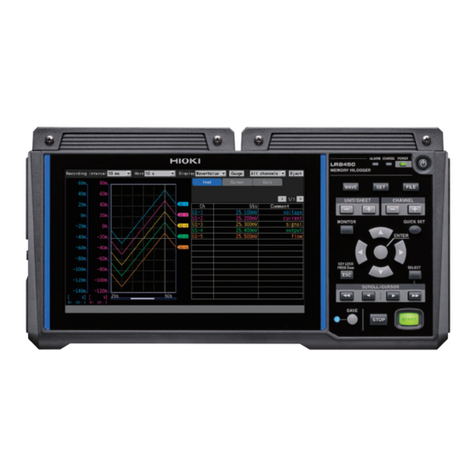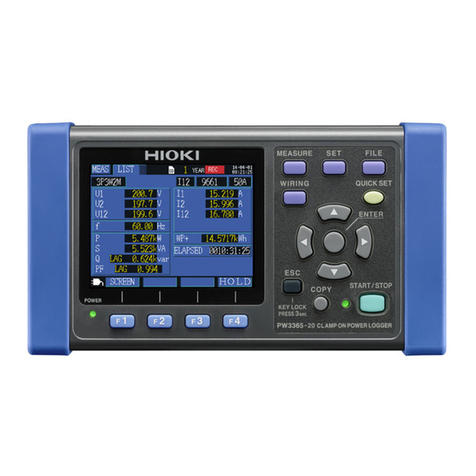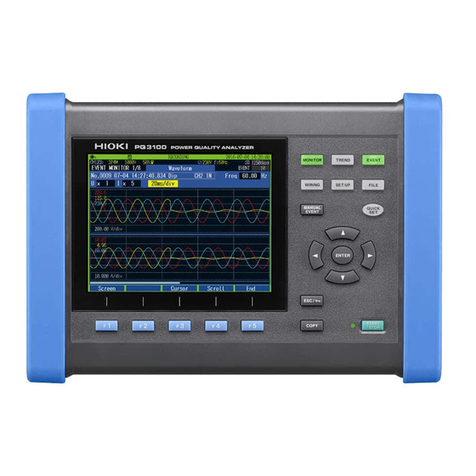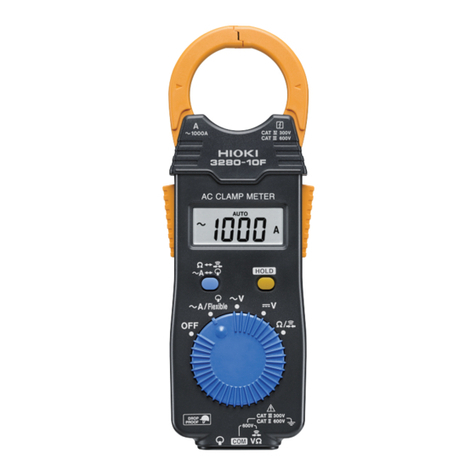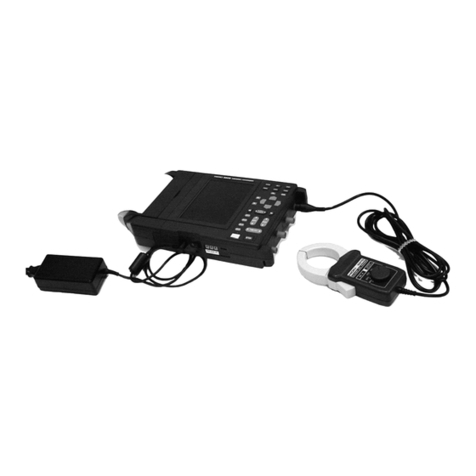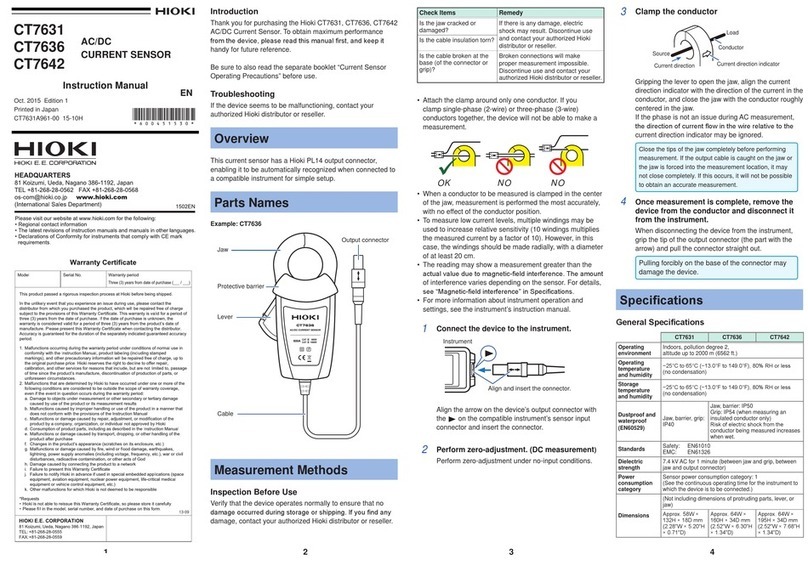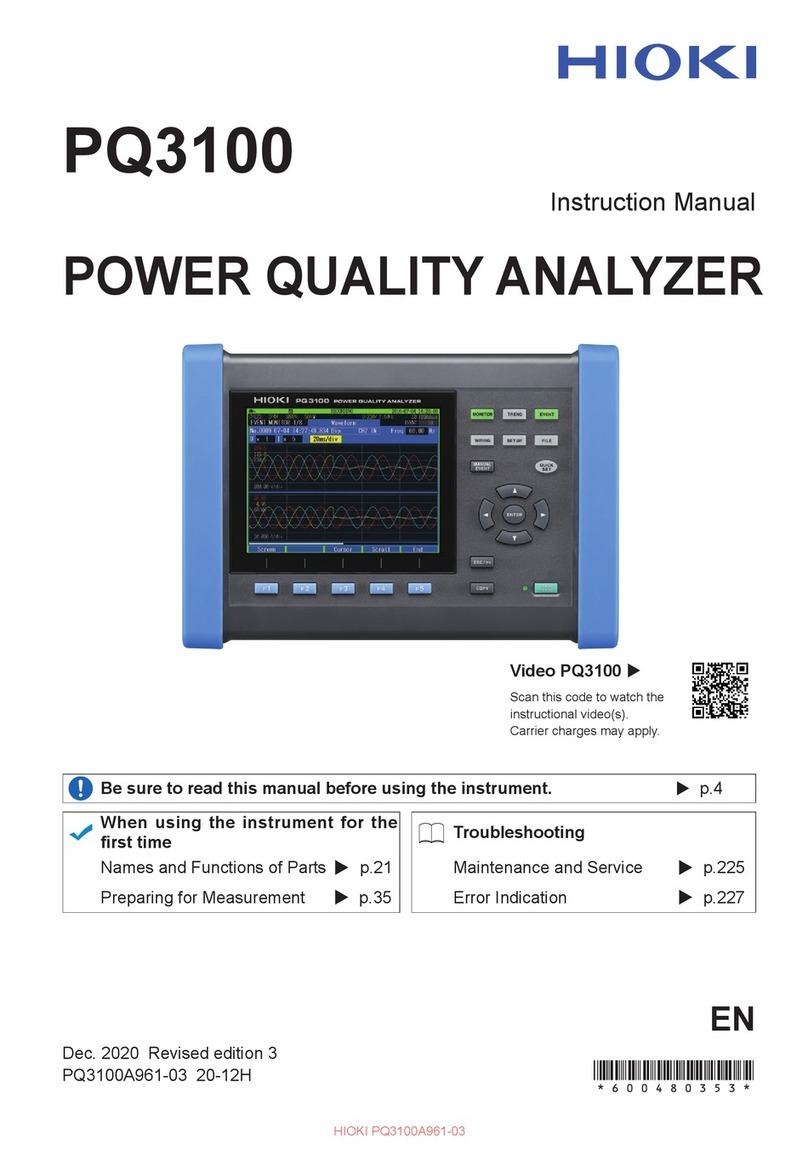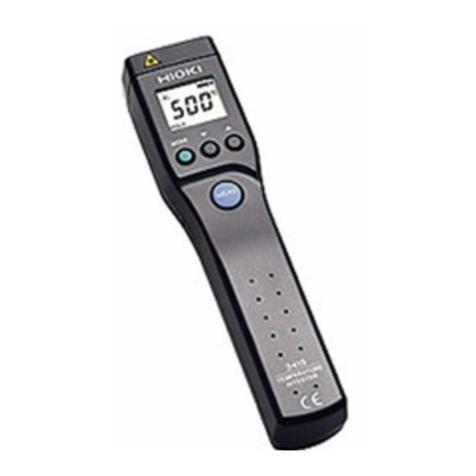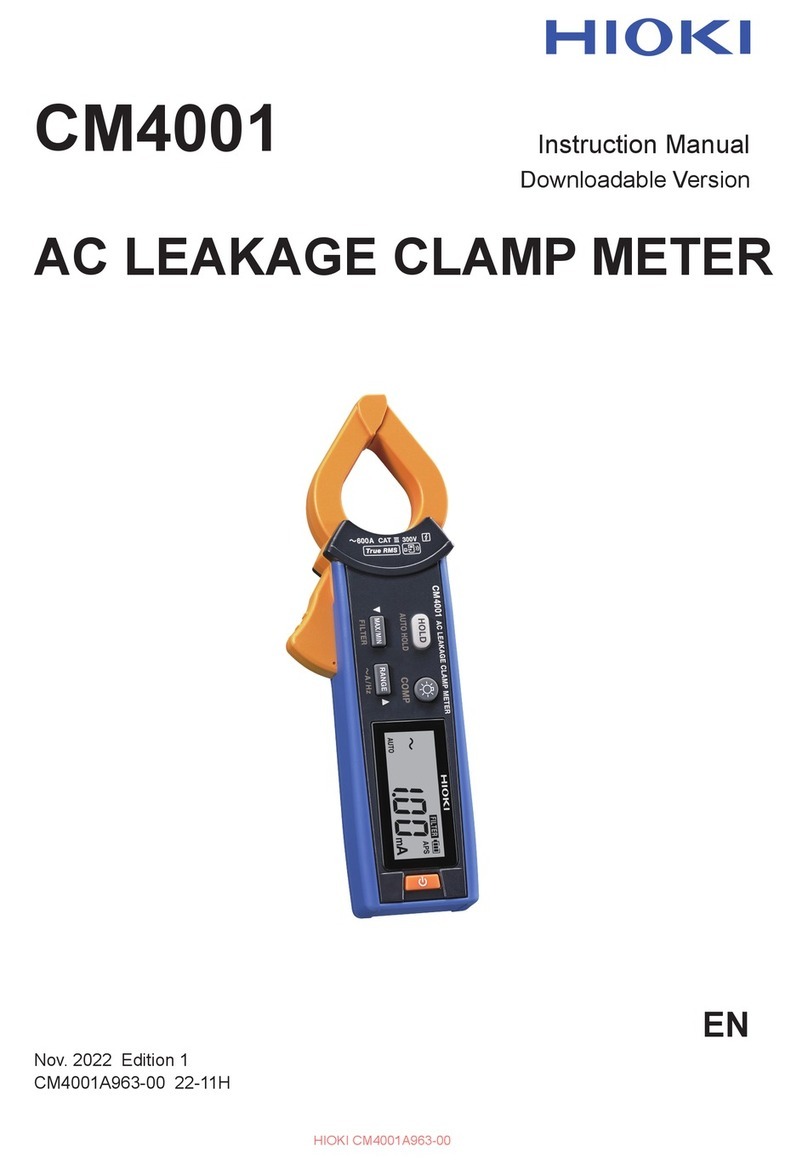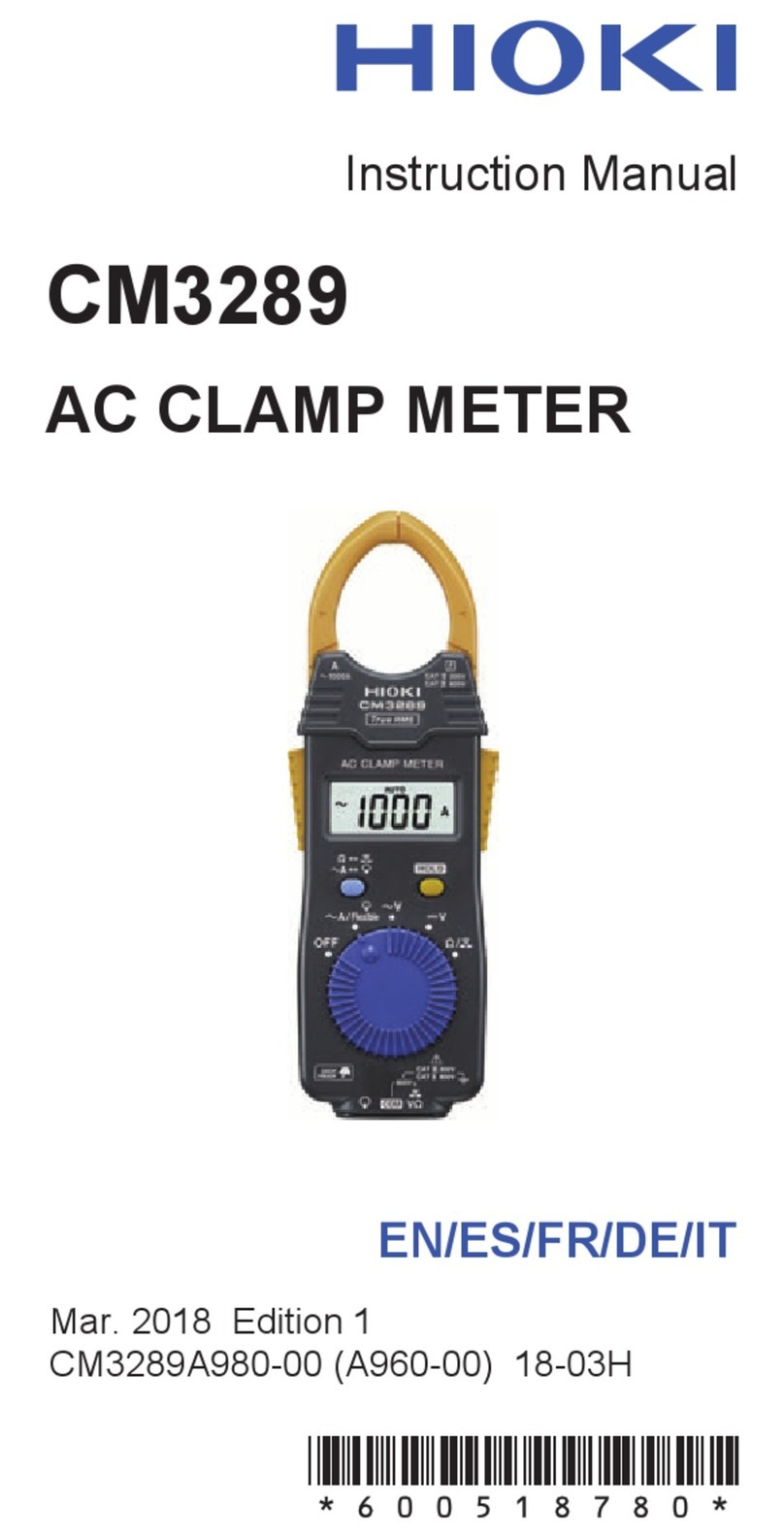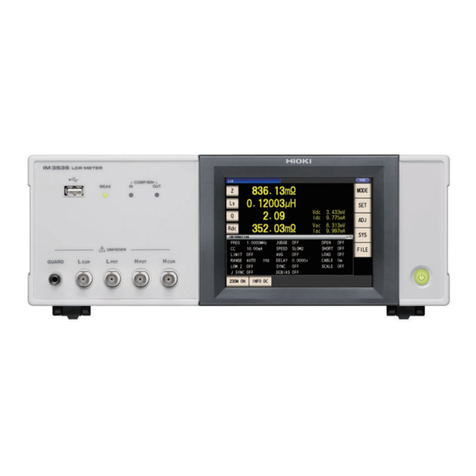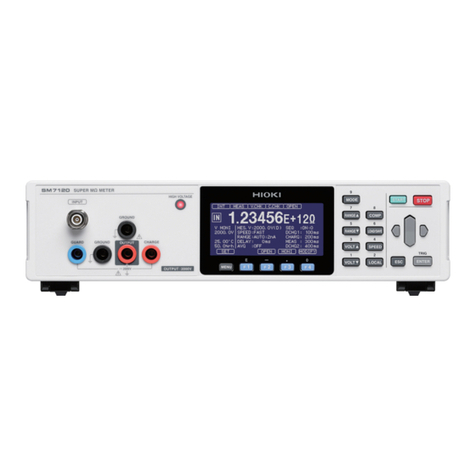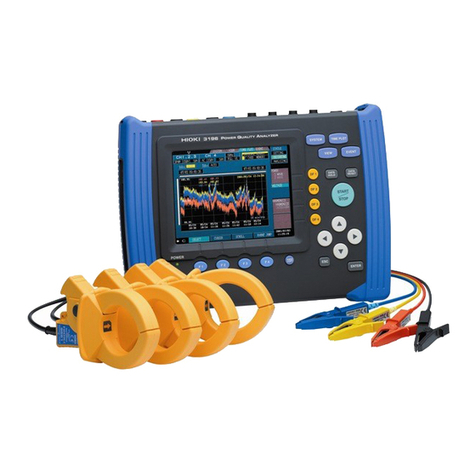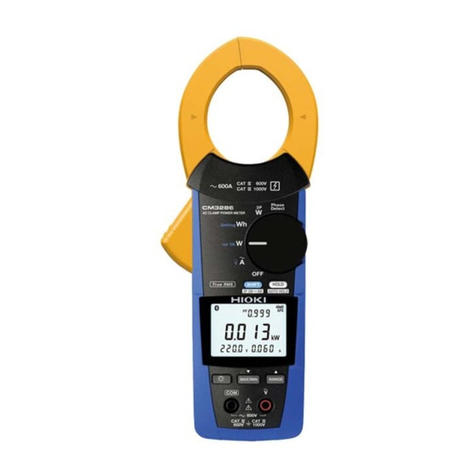
Warranty
Warranty malfunctions occurring under conditions of normal use in con-
formity with the Instruction Manual and Product Precautionary Mark-
ings will be repaired free of charge. This warranty is valid for a period
of one (1) year from the date of purchase. Please contact the distribu-
tor from which you purchased the product for further information on
warranty provisions.
Introduction
Thank you for purchasing the HIOKI Model CT9691, CT9692,
CT9693 Clamp on AC/DC Sensor. To obtain maximum perfor-
mance from the device, please read this manual first, and keep
it handy for future reference.
Initial Inspection
When you receive the device, inspect it carefully to ensure that
no damage occurred during shipping. In particular, check the
accessories, panel switches, and connectors. If damage is evi-
dent, or if it fails to operate according to the specifications, con-
tact your dealer or Hioki representative.
Maintenance and Service
• To clean the device, wipe it gently with a soft cloth moistened
with water or mild detergent. Never use solvents such as
benzene, alcohol, acetone, ether, ketones, thinners or gaso-
line, as they can deform and discolor the case.
• If the device seems to be malfunctioning, contact your dealer
or Hioki representative.
• Pack the device so that it will not sustain damage during ship-
ping, and include a description of existing damage. We do not
take any responsibility for damage incurred during shipping.
• When disposing of the unit, do so in accordance with all
applicable local regulations.
This manual contains information and warnings essential for
safe operation of the device and for maintaining it in safe oper-
ating condition. Before using it, be sure to carefully read the fol-
lowing safety precautions.
Safety Symbol
The following symbols in this manual indicate the relative impor-
tance of cautions and warnings.
Symbols for Various Standards
Measurement Categories
This device complies with CAT III safety requirements.
To ensure safe operation of measuring instruments, IEC 61010 estab-
lishes safety standards for various electrical environments, categorized
as CAT II to CAT IV, and called measurement categories.
CAT II: Primary electrical circuits in equipment connected to an AC
electrical outlet by a power cord (portable tools, household
appliances, etc.)
CAT II covers directly measuring electrical outlet receptacles.
CAT III: Primary electrical circuits of heavy equipment (fixed installa-
tions) connected directly to the distribution panel, and feed-
ers from the distribution panel to outlets.
CAT IV: The circuit from the service drop to the service entrance, and
to the power meter and primary overcurrent protection device
(distribution panel).
Follow these precautions to ensure safe operation and to obtain
the full benefits of the various functions.
Instrument Installation
Preliminary Checks
Before using the device for the first time, verify that it operates
normally to ensure that no damage occurred during storage or
shipping. If you find any damage, contact your authorized Hioki
distributor or reseller.
The CT9691, CT9692, and CT9693 Clamp on AC/DC Sensors
are designed to be used with the 3290 and 3290-10 Clamp on
AC/DC HiTesters or the CT6590 Sensor Unit (collectively, “in-
struments”).
The 3290 and 3290-10 automatically detect the sensor when it
is connected and set the range accordingly. This combination of
equipment can be used to measure DC, AC, and AC+DC cur-
rent in live lines.
CT9691 Clamp On AC/DC Sensor
CT9692, CT9693 Clamp On AC/DC Sensor
Perform the following inspection before starting measurement:
Do not attempt to modify, disassemble or repair the
device; as fire, electric shock and injury could result.
Safety
CT9691,CT9692,CT9693
CLAMP ON AC/DC SENSOR
Instruction Manual
Sept. 2015 Revised edition 2
Printed in Japan
CT9691A981-02 15-09H
EN
This device is designed to comply with IEC 61010 Safety
Standards, and has been thoroughly tested for safety
prior to shipment. However, mishandling during use
could result in injury or death, as well as damage to the
device. Using the device in a way not described in this
manual may negate the provided safety features.
Be certain that you understand the instructions and pre-
cautions in the manual before use. We disclaim any
responsibility for accidents or injuries not resulting
directly from device defects.
In the manual, the symbol indicates particularly impor-
tant information that the user should read before using the
device.
The symbol printed on the device indicates that the
user should refer to a corresponding topic in the manual
(marked with the symbol) before using the relevant
function.
Indicates a double-insulated device.
Indicates that the instrument may be connected to or dis-
connected from a live circuit.
Indicates that incorrect operation presents an extreme haz-
ard that could result in serious injury or death to the user.
Indicates that incorrect operation presents a significant haz-
ard that could result in serious injury or death to the user.
Indicates that incorrect operation presents a possibility of
injury to the user or damage to the device.
Indicates advisory items related to performance or correct
operation of the device.
Indicates the Waste Electrical and Electronic Equipment
Directive (WEEE Directive) in EU member states.
This symbol indicates that the device conforms to regula-
tions set out by the EC Directive.
• Using a measuring instrument in an environment desig-
nated with a higher-numbered category than that for
which the instrument is rated could result in a severe
accident, and must be carefully avoided.
• Using a measuring instrument without categories in an
environment designated with the CAT II to CAT IV cate-
gory could result in a severe accident, and must be
carefully avoided.
Operating Precautions
Avoid the following locations that could cause an accident or damage
to the instrument.
Exposed to
direct sunlight
Exposedtohigh
temperature
In the presence
of corrosive or
explosive gases
Exposed to
water, oil, other
chemicals, or
solvents
Exposedtohigh
humidity or con-
densation
Near induction
heating systems
(e.g., high-fre-
quency induc-
tion heating
systems and IH
cooking uten-
sils)
Exposed to
strong electro-
magnetic fields
Near electro-
magnetic radia-
tors
Operating temperature and
humidity range:
0°C to 40°C (32 to
104°F), 80% RH or less; no con-
densation
Storage temperature range: -10°C
to 50°C (14°F to 122°F), 80% RH
or less; no condensation
• Attempting to do so could cause a short cir-
cuit or accident resulting in injury or death.
• To avoid electric shock, do not remove the
device's case. The internal components of
the device carry high voltages and may
become very hot during operation.
• To avoid electric shock when measuring live
lines, wear appropriate protective gear,
such as insulated rubber gloves, boots and
a safety helmet.
To avoid damaging the sensor, do not input a cur-
rent in excess of the maximum input range. The
maximum input range varies with the frequency of
the measurement current. Note that continuously
inputting a high frequency will cause the clamp sen-
sor to generate heat.
• The tips of the clamp sensor are extremely delicate. Exer-
cise care in handling the sensor as deformation of the clamp
sensor or damage to the clamp surface caused by dropping
the sensor or bumping it into other objects may prevent ac-
curate measurement.
• Keep the clamp jaws and core slits free from foreign objects,
which could interfere with clamping action.
• To prevent cable damage, do not step on cables or pinch
them between other objects. Do not bend or pull on cables
at their base.
• Measurements are degraded by dirt on the mating surfaces
of the clamp on sensor, so keep the surfaces clean by gently
wiping with a soft cloth.
Overview
Parts Names
Pre-Operation Inspection
No. Inspection step
(Continue inspection if OK.) Corrective action
(Perform when unit fails
inspection.)
1Is the clamp cracked or dam-
aged? If there is any damage, electric
shock may result. Discontinue
use and have the sensor
repaired.
2 Is the cable insulation torn?
3Is there a broken connection
involving the connector or sen-
sor base?
You will not be able to perform
proper measurement. Cease
use and contact your dealer.
1
Perform zero-adjustment.
2
Connect the clamp sensor to the measurement target.
3
Remove the clamp sensor after measurement is complete.
4
Model CT6590
Measuring
instrument
Model 3290, 3290-10
Lever
Output
connector
Clamp sensor
Front side Back side
Sensor lock
lever
LOCK
position
UNLOCK
position
Cable
Protective
barrier
Output
connector
Lever
Cable
Protective
barrier
Clamp sensor
CT9692 CT9693
Lever
